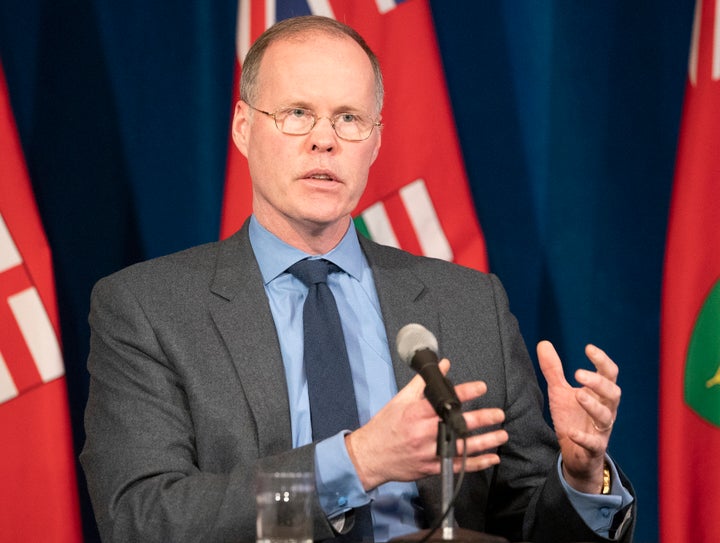TORONTO — “Am I missing something here or is this presentation actually predicting a disaster?” the TVO reporter asked.
“No, I don’t think you’re missing anything,” the official answered.
The exchange, from Ontario’s latest update for media on COVID-19 modelling, was unusually frank. A video clip of the moment shared widely on Twitter Thursday.
Thursday’s update was grim.
As lockdowns are lifted, Ontario could see between 5,000 and 6,000 new cases a day by the end of March, followed by an increase in hospitalizations and deaths, the modelling predicted. The deaths will be concentrated in low income and racialized communities, following a similar pattern to the previous 12 months.
It’s all because of a new variant of the virus, B.1.1.7, which was first detected in the United Kingdom and has already started tearing through Ontario nursing homes. There are also two other “variants of concern” spreading in Ontario, which originated in South Africa and Brazil.
“The data I’ll present today tells two stories. One story is the real success we’ve had with our current public health measures ... Mobility is down and with it, cases and hospitalizations for COVID-19,” Adalsteinn Brown, dean of the Dalla Lana School of Public Health at the University of Toronto, told reporters at the beginning of the briefing.

“The other story is about a real threat. The new variants of concern that spread so much more easily are here and they threaten to undo our progress.”
He said that the B.1.1.7 variant spreads much more quickly and may be more lethal than the strain of the novel coronavirus that’s already spreading. The best thing to do would be to stick with the measures that are in place now, do “aggressive vaccination,” and “hope for a late spring and summer that is much safer and more open,” Brown said.

The doctors’ presentation said the reproduction rate, the average number of people who someone with COVID-19 spreads it to, needs to be below 0.7 to prevent an overall increase in total cases. It’s currently between 0.8 and 0.9.
“If the B.1.1.7 variant behaves as it did in the United Kingdom, cases will start to grow here in late February or early March. That is, unless we can limit the spread through public health measures,” Brown said.
After first being detected, B.1.1.7 became the dominant strain in the U.K. in a matter of months, he said. Then, the number of cases tripled in just one month. Nurses were forced to care for four to eight times as many patients as usual and there were often days when more than 1,000 people died.
“We face the very real risk of a third wave and, potentially, a third lockdown.”
- Adalsteinn Brown
If the variant behaves the same way in Ontario, we will see an increase in new cases, starting later this month, followed by more hospitalizations and intensive care unit (ICU) admissions.
“We face the very real risk of a third wave and, potentially, a third lockdown,” Brown said.
But Premier Doug Ford has already announced he’ll ease restrictions.
Restaurants and non-essential businesses reopened in three areas — Hastings Prince Edward; Kingston, Frontenac and Lennox and Addington; and Renfrew County — when they moved back into the green zone Wednesday.
Retail stores will be allowed to reopen everywhere else on Feb. 16, except for hot spots Toronto, Peel and York, where stores will reopen the following week, Feb. 22.

That reality led to another very frank question from a reporter Thursday. This one was directed to the chief medical officer of health, Dr. David Williams, whose direction Ford says he relies on.
“So Dr. Williams, are you recommending that the province do anything else to ensure the old variant [reproduction] goes down to 0.7? Or are you really just letting this happen?”
Dr. Williams said the regions that have been allowed to reopen have reproduction rates between 0.4 and 0.6. There has to be a “fine balance” because a lot of people are “suffering economically,” he said.
“We’re not opening up. We’re allowing some things to be available.”
- Dr. David Williams, chief medical officer of health
“We’re not opening up. We’re allowing some things to be available. But we want even more personal adherence to the stay at home, to the masking, to limiting your household contacts. All of that has to be really carefully done in the next couple weeks.”
Earlier this week, Ford was asked if he still trusts the models, given that they predicted ICUs would be overwhelmed in January, which didn’t happen.
The premier responded by saying that he listens “100 per cent” to Dr. Williams and the doctors on the province’s other health tables.
“They give us the best advice they can at the given time,” he said.
“As everyone has seen, COVID-19 moves rapidly. With the new variants, it moves rapidly. It’s very fluid. What we do in January is not necessarily what we do in February or March.”
Prime Minister Justin Trudeau said Friday that Canadians are worried about the new variants, as they should be.
“We have gotten used to, over the past many weeks, making a number of sacrifices that have successfully brought the numbers down in terms of caseloads,” Trudeau said. “We’re going in the right direction and that’s a reason for cautious optimism. But at the same time as these new variants are starting to spread through the communities, we’re going to need to be extra vigilant and extra careful.”
With a file from Ryan Maloney